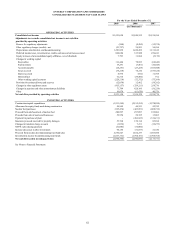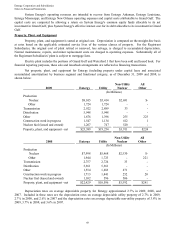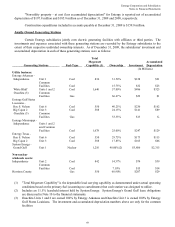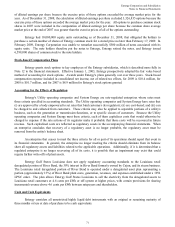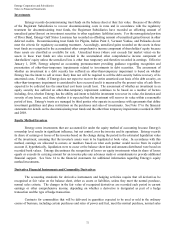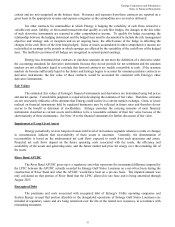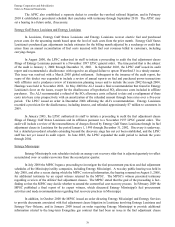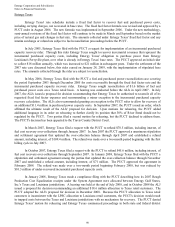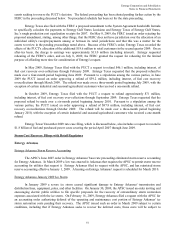Entergy 2009 Annual Report Download - page 73
Download and view the complete annual report
Please find page 73 of the 2009 Entergy annual report below. You can navigate through the pages in the report by either clicking on the pages listed below, or by using the keyword search tool below to find specific information within the annual report.
Entergy Corporation and Subsidiaries
Notes to Financial Statements
69
of diluted earnings per share because the exercise price of those options exceeded the average market price for the
year. As of December 31, 2008, the calculation of diluted earnings per share excluded 3,326,835 options because the
exercise price of those options exceeded the average market price for the year. All options to purchase common stock
shares in 2007 were included in the computation of diluted earnings per share because the common share average
market price at the end of 2007 was greater than the exercise prices of all of the options outstanding.
Entergy had 10,000,000 equity units outstanding as of December 31, 2008, that obligated the holders to
purchase a certain number of shares of Entergy common stock for a stated price no later than February 17, 2009. In
February 2009, Entergy Corporation was unable to remarket successfully $500 million of notes associated with its
equity units. The note holders therefore put the notes to Entergy, Entergy retired the notes, and Entergy issued
6,598,000 shares of common stock to the note holders.
Stock-based Compensation Plans
Entergy grants stock options to key employees of the Entergy subsidiaries, which is described more fully in
Note 12 to the financial statements. Effective January 1, 2003, Entergy prospectively adopted the fair value based
method of accounting for stock options. Awards under Entergy's plans generally vest over three years. Stock-based
compensation expense included in consolidated net income, net of related tax effects, for 2009 is $10.4 million, for
2008 is $10.7 million, and for 2007 is $8.9 million for Entergy's stock options granted.
Accounting for the Effects of Regulation
Entergy's Utility operating companies and System Energy are rate-regulated enterprises whose rates meet
three criteria specified in accounting standards. The Utility operating companies and System Energy have rates that
(i) are approved by a body empowered to set rates that bind customers (its regulator); (ii) are cost-based; and (iii) can
be charged to and collected from customers. These criteria may also be applied to separable portions of a utility's
business, such as the generation or transmission functions, or to specific classes of customers. Because the Utility
operating companies and System Energy meet these criteria, each of them capitalizes costs that would otherwise be
charged to expense if the rate actions of its regulator make it probable that those costs will be recovered in future
revenue. Such capitalized costs are reflected as regulatory assets in the accompanying financial statements. When
an enterprise concludes that recovery of a regulatory asset is no longer probable, the regulatory asset must be
removed from the entity's balance sheet.
An enterprise that ceases to meet the three criteria for all or part of its operations should report that event in
its financial statements. In general, the enterprise no longer meeting the criteria should eliminate from its balance
sheet all regulatory assets and liabilities related to the applicable operations. Additionally, if it is determined that a
regulated enterprise is no longer recovering all of its costs, it is possible that an impairment may exist that could
require further write-offs of plant assets.
Entergy Gulf States Louisiana does not apply regulatory accounting standards to the Louisiana retail
deregulated portion of River Bend, the 30% interest in River Bend formerly owned by Cajun, and its steam business.
The Louisiana retail deregulated portion of River Bend is operated under a deregulated asset plan representing a
portion (approximately 15%) of River Bend plant costs, generation, revenues, and expenses established under a 1992
LPSC order. The plan allows Entergy Gulf States Louisiana to sell the electricity from the deregulated assets to
Louisiana retail customers at 4.6 cents per kWh or off-system at higher prices, with certain provisions for sharing
incremental revenue above 4.6 cents per kWh between ratepayers and shareholders.
Cash and Cash Equivalents
Entergy considers all unrestricted highly liquid debt instruments with an original or remaining maturity of
three months or less at date of purchase to be cash equivalents.
71



